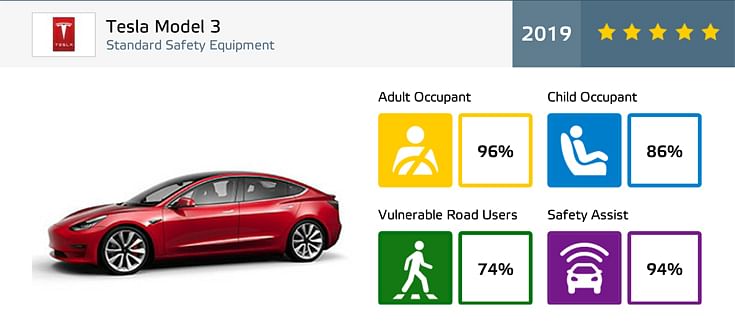Tesla Model 3 gets top 5-star rating in Euro NCAP crash test
This is one of the highest scores ever recorded by Euro NCAP, largely down to the car's skateboard chassis layout which creates a low centre of gravity, and the absence of a combustion engine.
The Tesla Model 3 has made a strong debut with a perfect score in the frontal offset deformable barrier crash test, a mainstay of Euro NCAP’s assessment since its inception in 1997.
This is one of the highest scores ever recorded by the organisation. This was largely down to the cars's skateboard chassis layout, which creates a low centre of gravity, and the absence of a combustion engine, which could otherwise have the potential to intrude on the passenger compartment in the event of a collision.

The electric sedan’s performance in the Safety Assist tests particularly impressed, thanks to its superb driver assistance systems like lane support, speed assist and autonomous emergency braking. The Tesla’s 94 percent score in 2019 Safety Assist tests is the best yet under Euro NCAP’s most recent protocol.
As per Euro NCAP’s test notes, the Tesla Model 3’s passenger compartment remained stable in the frontal offset test. Dummy readings indicated good protection of the knees and femurs of both the driver and passenger dummy. Tesla showed that a similar level of protection would be provided to occupants of different sizes and to those sitting in different positions. Protection of both dummies was rated as good for all critical body areas and the Tesla 3 scored maximum points in the offset deformable test. In the full-width rigid barrier test, all body areas were well protected for both dummies with the exception of chest of the rear passenger, protection of which was adequate.
In the side barrier test, protection of all critical body areas was good and the Tesla 3 scored maximum points. In the more severe side pole impact, dummy readings of rib compression indicated marginal protection of the chest, with all critical areas well protected.
Tests on the front seats and head restraints demonstrated good protection against whiplash injuries in the event of a rear-end collision. A geometric assessment of the rear seats also indicated good whiplash protection. The standard-fit autonomous emergency braking (AEB) system scored maximum points in tests of its functionality at the low speeds at which many whiplash injuries occur, with collisions avoided in all test scenarios.
Euro NCAP says, the AEB system performed well in tests of its response to other vehicles at highway speeds. The lane support system helps to prevent inadvertent drifting out of lane. The system can also intervene in some more critical situations. There is a seatbelt reminder for the front and rear seats. A speed assistance system uses digital mapping to identify the local speed limit and presents this information to the driver, allowing easy activation of the limiter to the appropriate speed.
Also read: Tesla Model 3 is Europe's best-selling EV
RELATED ARTICLES
Volkswagen Group honours 10 outstanding suppliers, strengthens strategic collaboration
The 21st Volkswagen Group Award recognized suppliers for outstanding performance and contribution over the past year. VW...
Volkswagen Group sells 465,500 BEVs worldwide in first-half 2025, up 47%
With strong growth in Europe (+89%) and the USA (+24%), despite a sales decline in China (-34%), the VW Group’s global B...
Skoda begins sale of made-in-India CKD Kushaq in Vietnam
Before production started, pre-series Kushaq vehicles covered over 330,000 kilometres on a variety of Vietnamese roads a...





 By Autocar Professional Bureau
By Autocar Professional Bureau
 03 Jul 2019
03 Jul 2019
 8565 Views
8565 Views


















